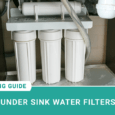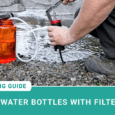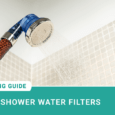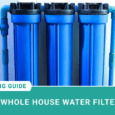Today we’re on an adventure called finding the best water softener on the Internet! Yeah, we know, seems like a very tricky task, but we did our research and we’re confident with what we’re bringing to you today!
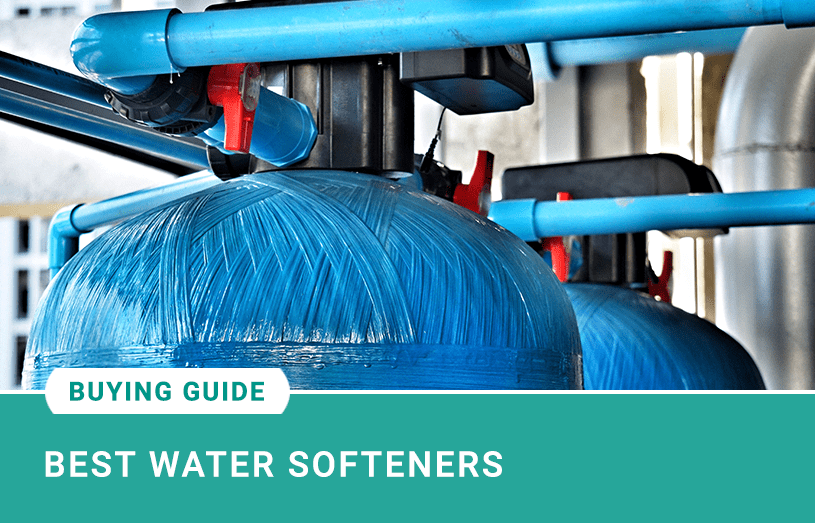
First, off we’ll go over the basics: we’ll let you know what a water softener is and what it’s supposed to do. After that, we’ll run over the most popular products and we’ll weigh out the pros and the cons for each, which is supposed to help you pick the one that suits you most.
However, maybe you should give the whole article a read and then go over the products, because we’ll talk about buying tips, picking the right product for you, features to keep in mind and we’ll also go over the important stuff people forget: installation and maintenance.
Without any further ado, let’s jump into the topic.
The Basics About a Water Softener
With the popularity of water filters growing daily, many people are also getting interested in water softeners. These devices are somewhat similar to filters, but they do a whole different thing. It’s just a mechanism that’s sort of similar.
A water softener is supposed to make hard water soft. Hard water is just a people-given name for water that has a lot of dissolved minerals. Having calcium, magnesium, and iron in your water is not necessarily bad, but you surely shouldn’t have a lot of it because it can damage your piping and the gadgets that you’re using.
If your water cannot get foamy and your laundry is very rough when it comes out of the washer, that can also be a sign of hard water. Long term, it’s not good for people to drink that kind of water and that’s why many opt for a water softener.
Best Water Softeners
Let’s go over some of the most popular models on the Internet, discuss their pros and cons and see which features may suit you best. It’s also a good idea to keep track of which products seem to be your favorites.
Fleck 5600SXT 48,000 Grain Water Softener
Our first product on the list is a digital water softener that keeps track of all of the info about your water. T’s a black 14×34 inch tank that includes a bypass valve. You can expect a rate of 28 GPM, which can serve the whole family on a daily.
The efficient design is made to remove scale, water spots, and residue that’s left from soap. You can easily adjust the parameters digitally and personalize the whole experience. There are video installation tutorials that will help you include this system in your home with minimal issues. It shouldn’t take longer than 2 hours
The tank is so durable that you’re getting a 10-year warranty! It’s so tough that it can be installed outside, and it will do great even in bad conditions!
| Feature | Info |
|---|---|
| Digital 5600SXT Metered Control Head | A simple, efficient design to eliminate scale, water spots, and soap scum. Metered design measures water usage and regenerates as needed. |
| High capacity resin | High capacity resin with standard 8% crosslink offers high quality water softening at a low price. |
Pros:
Cons:
Check The Latest Price On Amazon
Nuvo H20 Dphb-a Home Water Softener System
Next up we have a smaller system that works by lowering your water’s pH in order to remove the minerals that are creating this sensation of „hard water“. These are usually calcium and magnesium, but it can be a bunch of other ones as well.
This softener will save you cash and will protect your pipes and faucets from getting covered in scale build-up! The gadget is approved both by NSF and FDA and it is the perfect companion for those who live in a small household.
Don’t worry about the planet – this product is eco-friendly and it doesn’t waste any water, nor does it require electricity. The cartridge needs to be replaced every 20 000 gallons, which will be a long time for most. Just estimate your daily gallon usage and do the math yourself!
| Feature | Info |
|---|---|
| FDA & NSF approved | For homes with 1 – 2 residents. |
| Good for Home | Extends the life of your water heater, plumbing fixtures and appliances. |
Pros:
Cons:
Check The Latest Price On Amazon
Whirlpool WHES30 30,000 Grain Water Softener
If you’re looking for something that’s a bit cheaper and more beginner-friendly than the first few products on the list, you should look into this. It is ideal for households that are anywhere between one to four members big.
The filter can remove up to 8 ppm of iron and is certified by NSF, which proves its efficiency. The best thing about the gadget is that it can calculate how much salt and water is needed in the process, so it saves a bit of both altogether.
You’re getting a 1-year warranty for this filter that removed 95 grains per gallon, and also removes excess calcium, magnesium, manganese, and iron.
| Feature | Info |
|---|---|
| Soften Your Home’s Water | The most efficient and cost-effective way to save your family from itchy and dry hard water is installing a water softener that is proven to replenish their skin. |
| Reduce Potential Scale Problem | Hard water build-up, or scale, can impact your home’s water pressure. Scale can also stain showerheads and faucet fixtures. |
Pros:
Cons:
Check The Latest Price On Amazon
On The Go OTG4-DBLSOFT-Portable 16,000 Grain RV Water Softener
This water softener is a heavy-duty one, and it produces double as many gallons as the other competitor models on the market. It’s not even that big and you won’t have an issue with installation.
It’s a 16 000 grain unit that supplies you with double the amount of water in only 30 minutes. The unique features include a carrying handle, a large opening for the addition of salt, as well as a premium resin.
You can use a standard garden hose with it and you don’t need any tools nor an electrical source to keep this thing working.
| Feature | Info |
|---|---|
| RV/Marine | Built for the owner of any RV/Marine model, this 16,000 grain unit is a perfect fit and supplies approx. 40% more soft water than any other unit on the market. |
| Compact | Its compact, space-saver design allows it to be installed in the tightest places. |
Pros:
Cons:
Check The Latest Price On Amazon
Iron Pro 2 Combination Water Softener
The next gadget on the list is a 64 000 grain capacity that’s meant to do double duty – it does both filtering and softening. The gadget has an LCD screen with a backlight and it can filter about 1 gallon per minute.
The tank itself is easy to set up once that you realized how the installation works. There are four modes the gadget can work on, which helps you gain full control over the functions. The gadget also has the mode to backup the settings in case of power loss.
| Feature | Info |
|---|---|
| Round Brine Tank | Round brine tank holds salt used for regeneration. Safety float prevents accidental overfilling. |
| Bypass and 1″ Connection | Standard 1″ MNPT thread for easy connection to your plumbing, Bypass valve allows the system to be bypass for any reason without shutting off the main water supply. |
Pros:
Cons:
Check The Latest Price On Amazon
AFWFilters Fleck 64k Water Softener
This filter is a perfect one for those who are not sure of the installation process. You can easily get free support from the manufacturer’s technician. It comes with a standard paddle wheel meter and it’s a 64 000 grain softener.
If you decide to do the installation yourself, you can watch the video instructions. The digital meter head helps you get an idea of what the current water status is. You can personalize the experience and make the filter last much longer that way.
The GPM is anywhere between 14 and 16, which means that you can get a proper efficiency for the whole household, but you can’t expect wonders.
| Feature | Info |
|---|---|
| Standard Brine Tank | Standard brine tank holds salt used for regeneration. Safety float prevents accidental overfilling. |
| Installation Guidelines Included | Comes with Video instructions on USB drive plus install kit pictured. |
Pros:
Cons:
Check The Latest Price On Amazon
Tier1 Digital Water Softener For Hard Water
Our last product on the list is this 48 000 grain softener with a digital screen. It saves you money in the long run and has a very smart design – the precise turbine is made to be efficient, but not to consume much energy.
You can fully adjust cycle times and the polystyrene resin. The flow rate of the gadget is about 11, and the pressure goes from 20 to 120 PSI. The user-friendly LCD interface will be of much help, but the support team is always online to help you.
| Feature | Info |
|---|---|
| Prevents Limescale Build-up | Hard water (calcium & magnesium) is a common problem for many homeowners and businesses. When hardness minerals are combined with heat it forms troublesome scale. |
| Digital Meter Control Valve | LCD display, improved features and ease of operation as compared to Fleck 5600SXT. |
Pros:
Cons:
Check The Latest Price On Amazon
How Do Water Softeners Work
The technology included in water softeners is certainly not a simple one, but it can be simplified in order to be explained. The actual process is mostly a result of the natural characteristics of ions and minerals, and we humans just learned how to take advantage of those.
Did you ever consider using a Whole House Water Filter? Read the linked article and find out which one is the best for you.
So the actual process is called ion exchange. The ions of unwanted elements are pushed out and replaced by another, better ion that the system projects. There are usually a few steps in this process and we’ll go ahead and explain what each part of the system does to help it.
Prefiltering
To begin with, there is no use in making hard water soft if it’s dirty. That’s why the prefilter removes big particles of dirt like sand, rust, and soil. That way you’re also prolonging your filter’s lifetime because the big particles are not entering the fine mesh.
The resin tank
This is the part where the „active ingredients“ go to work. Basically, it’s a tank where the small beads go, and they force the ion exchange process. Actually, the material they are made of forces the whole thing. The ions of the beads push out the ions that are making the water hard and it’s usually sodium that the beads are made of.
Brine Tank
Next up we have the brine tank, where the beads are. The beads are here when they are not pushed into the process.
Control Valve
Obviously, there is no use in having his cycle work each second. That would completely drain the filter and a certain volume of water would be filtered multiple times. Because of that, the control valve controls the timing and detects when new water is back in.
Is Soft Water Safe to Drink?
Our primary concern is often related to our health. That’s probably the reason why you’re getting a water softener in the first place. Well, let us explain. The only difference between hard and soft water is in the number of ions of certain minerals.
The ions in soft water are balanced, and in hard water, they are not. Nothing is added or completely removed, it’s just „fixed“. Therefore if your water was safe before softening, it’s safe after as well. If you’re additionally worried about things that softeners cannot remove, bacteria and organic compounds, for example, you should get a carbon filter that will fix these things for you!
Why Do You Need a Water Softener?
Whenever we’re spending money, it’s natural that we’re skeptical. Do I really need this? Do I have to do this? Am I in danger if I don’t? Well, let’s clear things out for you by presenting you with the fact that say how important water softeners really are.
Protect your pipes and your faucets
Anyone who has been cleaning their faucet has probably noticed a few unattractive side effects of hard water. The first is usually the stains that happen in your sink and your bathtub. These are usually somewhat grey or yellow and they can be removed with vinegar and a lot of scrubbing, but they could also be prevented, and that seems like a much better idea.
No more need for a plumber
The scale is a result of hard water changing states during transport. It turns into steam and then turns back into water, depending on the temperature. Because of that, the scale-like white residue covers the plumbing and can create a whole blockage. You’ll have to call in the plumber to fix that issue for you, which is money thrown away.
Better hair, nails, and skin
Those who usually struggle with acne, psoriasis and dry, flakey skin should know that you’re actually making the problem even worse with the hard water you’re using on your skin. You should opt for a softener, and maybe even a vitamin infuser if you wish to get the best effects.
Reduce soap usage
Did you know that soap cannot foam up as well in hard water? The same goes for shower gels, shampoos, and other foaming products. This means that you have to use more of them to get the same effect you would with soft water, and that ends up being an additional cost.
Make your laundry softer
It’s important to understand that hard water runs through all of the appliances in your home and that would mean that your washer is affected as well. Besides it has a higher risk for corrosion, there is also the sensation of „rough“ laundry. If you’re using soft water, you don’t need to use additional products that you usually pour into the machine.
How to Pick the Right Water Softener for You?
All of this advice is worth nothing if you still don’t know what to do with the list of the best water softeners provided on the Internet. It’s completely okay if you’re overwhelmed and if you’d like to do a bit more research before you make an informed decision. That’s why we’re going to talk about the key features and advice you should take into account now that you’re buying a softener.
The Most Popular Types of Water Softeners
Naturally, it’s good to check out some of the more popular gadget types before deciding which one to get. This will narrow down the choices a lot and will give you a clearer picture of what you’re choosing your product from.
Salt-based Softeners
These are the classics amongst water softeners and what they are all about is sodium. The ion exchange exchanges sodium for something else, and that’s the main characteristic of this process.
Salt-free Softeners
On the other hand, you can get salt-free ones. These are much less effective and mostly work only as water conditioners, gadgets that only prevent the buildup of limescale and other side effects. They don’t actually make hard water soft, they only sort of mask the consequences.
Dual Tank Softeners
Those who are looking for a heavy-duty softener should look into these bad boys. You’re essentially working with two iron tanks that provide you with soft water at all times. When one is in stand-by, other is working. That’s what gives them the time to reset and maintain their maximum efficiency.
Magnetic Water Descalers
These are not so conventional and are much rarer than the others. These devices are electrical, which means that you don’t have to install them into your plumbing. It’s just a few wires that have to be set up and the device creates a magnetic field that will warp the usual properties of ions. This system is as effective as the non-salt softeners.
Features to keep in mind
Not all features are equally important. That’s something that needs to be said more because companies tend to push this „we have all of the best features“ marketing on customers, although it’s not necessary to focus on every single aspect of the product. Let’s debate those that are actually important, shall we?
Capacity/Grain Rating
Capacity is one of those things that are actually relevant because they will dictate the efficiency of your gadget. Obviously, the rule is simple, bigger is better. When we talk about capacity, we don’t talk about the actual tank where the water goes. We talk about the capacity of the resin. The resin is where the impurities end up after being filtered, and you want the resin to be able to hold up a lot of grains.
You should not settle for anything below 16 000 grains. The biggest units can hold up to 96 000, but the golden number lies somewhere in the middle.
The Size
While some portals never talk about the importance of dimensions, we feel like a little reminder would be okay. If you buy a fantastic softener and you have nowhere to install it because it exceeds the size of the place where you should have put it, there is no point in owning one. Make sure to read the dimensions and have that in mind.
The Hardness Level of Your Water
Some water is harder than the other, and that’s why you need to keep in mind the efficiency of your gadget. Although „heavy-duty“ products seem like a good idea anytime, you shouldn’t go over your cash limit to get a pricey piece if your water needs just a little work. Try to test the pH and see how off it is from the pH that’s normal for water, which is seven.
Flow rate
If you’re getting a water softener for a specific room, you don’t need to worry too much about flow rates. However, most people want to get systems that work in their whole house and that’s where higher GPM’s come in handy. You want as many gallons per minute as possible since there can be quite a lot of multitasking happening in one home. Specifically, cooking a soup while someone is taking a shower can be a problem.
The Final Words of Advice
The key to saving cash while still focusing on the key features is to decide which features are actually key for you. Do you really need that flow rate if it’s drinking water only you are softening? Is size a problem or can you fit the gadget in the basement as well? Prioritize things.
The Small Tricks to Perfect Water Softeners
Let’s go over the small tips and tricks that are random, but surely need to be mentioned in order to get the filter that’s really compatible with you and your household. Good features aren’t always needed, and you could save some serious cash by using these tips!
- 1-piece vs 2-piece systems. Do you need to supply a large house or are you just focused on one room? It’s usually cheaper to get 2-piece softeners because the electronics at the top are not as corrosive and they need less maintenance.
- Stick to the not-so-famous brands. They usually have parts that are easier to replace and they are cheaper to find, and the quality of famous brands is not as high as you may think.
- You want to get something that has already been researched because that was you’re into a much smaller risk. Things that have been running smoothly for years are usually easier to fix as well, which means that your cost of reparation and spare parts is lower.
- Make sure to consult with a mechanic or someone similar to see how this gadget does regarding possible issues that may be re-occurring.
How to Install Your Water Softener?
Let’s now go over the specifics of how you can install a water softener. It’s an easy job in most cases, which ends up being a couple bucks saved because you don’t need to call in a plumber. However, if you’ll install it and then see that something’s not fine, you have created an even bigger issue because now you need to disassemble the whole thing and call a plumber.
Make sure to take into account whether you’re actually good at this stuff, because you may save yourself a few bucks, but it’s not going to be worth it.
- Shut the water supply off. Make sure that you locate it and turn it off so you don’t have water flying around once you start to open the pipes.
- Cut the pipes before the pipe enters the house.
- Attach the pipe connection. This is where you need to pay attention to the special installation guide that usually comes with the product itself because there are several valves that you need to know when you’re connecting them.
- Ensure that connectors are in place. They need to be tight and soldered possibly.
- Connect the media tank and the brine tank together with some tubes. It’s usually 3/8 tubing that’s provided, but you may need to look into the specific package that you’re getting to see whether everything you need is actually included.
- Connected the drain line and the drain elbow, and then connected the discharge pipe with the drain that transports wastewater.
An extra tip is to read the whole guide to an installation before starting, just to get an idea of do you have all parts and how long may it take for you to actually do the whole thing.
Maintenance and Troubleshooting
No system will do its work properly if you don’t make sure that it is clean and functioning at all times. That’s why you need to check it every now and then, clean it and see if all parts are still intact. The best tips would turn the water off before you clean the tank and replace the needed parts.
What to Do If Your Water Softener Is Not Working?
- Check the power cable. If your gadget works thanks to an electrical current, make sure to see whether the current actually gets into the system and does it do anything. If the current doesn’t get into the system, that’s why it doesn’t work.
- Check to see whether the bypass valve is open. This is a very simple problem that gets overlooked easily.
- See whether there is enough salt in the tank.
- Restart the gadget if possible, or open a new cycle if you think the current one stopped before it should have.
- Call a plumber if you think that there is an issue with the installation.
Most Common Water Softener Problems and The Solutions
Blockage
It’s not uncommon to see a blockage in the plumbing or in the gadget itself. The signs of a blockage are simple – water isn’t running as well or it isn’t running at all. The solution to this issue is tapping several parts of the gadget to make the salt break. You can sometimes even scoop out the blockage.
Motor failure
The motor of the gadget is the thing that makes it run, and when it’s broken, the gadget is unusable. The solution to this issue is to contact the manufacturer and ask them what the lifetime of the motor is and how would you be able to detect whether there is an issue with it.
The filters are dirty
When you first get your gadget, the performance of your filter is phenomenal and everything is great. Eventually, your filter will get dirty and the resin will be full of the filtered content. Make sure that you follow along on the number of months that your filter is supposed to work. After that, you have to replace the filter.
Summary
Now that you are familiar with water softeners – the way they work, the way they are maintained and installed, the categories and the features, you should be able to make an informed decision and pick a product from the list easily.
We advise you to track the features that are important to you and to check out the list once more in order to be able to choose the perfect product this time and get the best water softener system for you.

